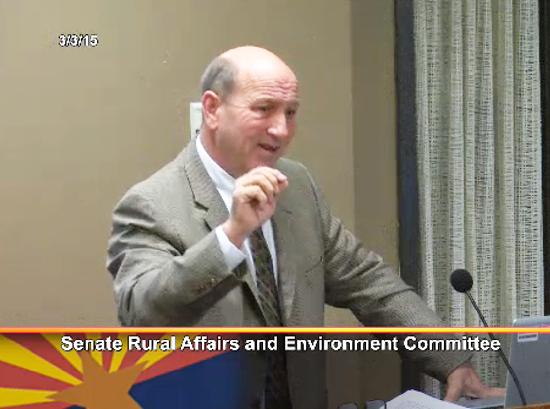
By Phil Riske | Managing Editor
Dust in the wind
All we are is dust in the wind ~ song lyrics by Kansas
(STATE CAPITOL) – After highly scientific presentations about air quality measurements, a Senate committee Tuesday morning gave a do-pass recommendation to a bill (HB2394) to remove an 18-month delay for compliance with the agricultural general permit and requires immediate compliance with the permit beginning January 1, 2016.
The measure, which passed the House 58-0, expresses confidence Pinal County can reach federal standards for air quality after months of back and forth between the Arizona Department of Environmental Quality (ADEQ) and the federal EPA over dust particulate levels in agricultural areas, where farming and ranching are a $1B industry.
“It’s EPA’s job to set the rules, and the state’s job to follow them,” ADEQ Director Henry Darwin told the Senate Committee on Water and Energy, which forwarded the bill 5-0.

Darwin said Maricopa County has met EPA air quality standards, and plans are to replicate plans to meet the standards for Pinal and Yuma counties.
There are bureaucratic and scientific challenges in reaching air quality attainment, witnesses told the committee.
Bas Aja, representing Arizona Cattlemen, said OSHA has a better perspective on agriculture-related dust pollution than does the EPA as it relates to earth crust dust and fine dust. He said crust material should not be included in air quality measurements.
Darwin said a major challenge facing Pinal County is the location of air monitors, which, he said, should not exclusively be in rural areas, but it’s difficult to get approval to move them.
He said one violation at one monitor site could place the entire county and state in non-attainment of air quality standards.
Another problem are “exceptional events,” spikes in pollution readings that have to be immediately investigated to decide whether they were man-made. Each investigation can cost up to $25,000, Darwin said.
Pinal County is required to meet air quality standards in four categories, plus levels for P10 dust particulates. Beef feedlots have struggled to meet dust attainment levels as cattle drag their hind hooves, kicking up dust.
Aja estimated the new rules could cost beef growers $1.2 million.
The EPA in 2000 told Pinal County it was 13 percent of the air pollution problems, the “worst” in the state.
Bill supporters say the pressure is on the EPA now to work out an agreement with Pinal County because the federal agency would not achieve its goal if it continued to pick apart the county’s plan.
Ironically, Rep. Frank Pratt, a prime sponsor of HB2394 could not make Tuesday’s hearing because he was delayed by visibility problems on his drive from Casa Grande.
Related: In Coolidge … Farming Is Still At The Top











